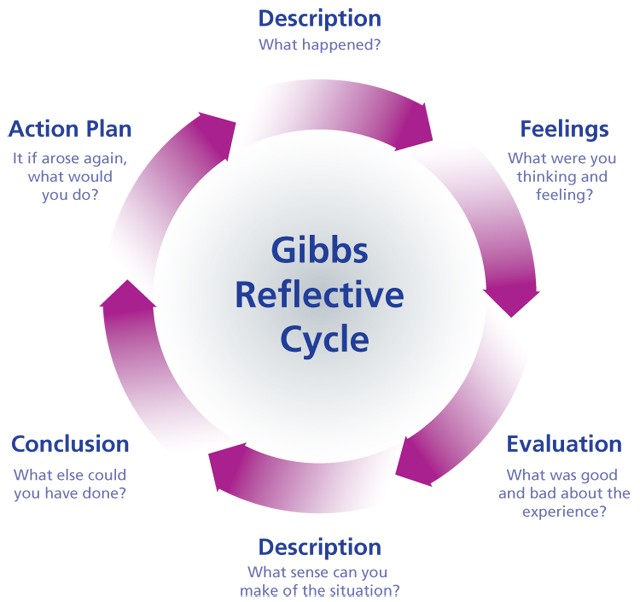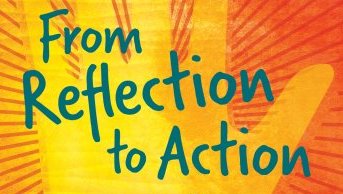Becoming Miss McCaughley – The Music Teacher
After a few days of observing Mrs Harrison teach her classes, it was now my turn to teach the Year 9 class, and in preparation, Mrs Harrison and I worked out a lesson plan. Having a limited experience with lesson planning, I did some research and found that effective lesson plans include 3 main components; 1) Objectives for student learning, 2) Teaching/learning activities, and 3 ) Strategies to check student understanding.[1]

After now completing that first lesson I can reflect on how it went, and I will evaluate my performance using the Gibbs’ Reflective Cycle. I had to teach the class of 12–13-year-old girls about the meaning of Riff, Hooks, Drones and Ostinatos. The first thing I did to prepare for this lesson was look at the Year 9 booklet, which is available to all the students, as I wanted to make sure everything I said coincided with what was in their work booklets. From this, I was able to create a PowerPoint using the information in the booklet and my own knowledge on the subject. I included YouTube links[2] that I knew the children would enjoy listening to music that they knew, and learning at the same time. I also thought this was a good learning technique as I know for personal experience if the same person is talking for a long time you can drift off, whereas if I was to play music, it would draw their attention. I was unsure as to whether or not I should use a Powerpoint, as they can be seen as useless, however with some research, I found that PowerPoints ‘helps structure the process of a lesson or lecture, preventing it from rambling.’[3]
I did, however, find it difficult to get the kids to respond to some of my questions making it hard for me to know if they understood my teaching. I learnt that the best thing to do when teaching for the first time is to get to know the pupils, Paul Harris explains that ‘in the first lesson you need to discover some of your pupil’s interests’ [4] although this is aimed for private lessons, I wanted to take this and use it in my first lesson.

Before beginning the class, I felt nervous that this might happen – that the children would not respond. To overcome these nerves, I had a pep-talk with myself. I am confident in who I am and like how I come across as I believe I am quite a bubbly, approachable person, so I reminded myself that I can make the children feel comfortable with my personality. I am aware of the age difference between myself and the students, only 10 years, but I make sure not to let this affect my teaching in a negative way, instead I think about how I could benefit from this. I make sure to use this to my advantage as I can easily relate to the students and take this as a chance ‘to use their youth and shared culture to advantage in their teaching.’ [5]
When the pupils did interactive I thought it would be good to use the STAR technique to answer their questions. ‘Using this strategy is particularly helpful in response to competency-focused questions’[6] With this technique I was able help the children better understand the subject. One pupil asked me how a Riff is created. I set the scene by explaining how a song is made through a simple idea, then explained that you can create a riff using a certain amount of notes, I played the riff I just made up and then showed them the final result. This really helped the children to understand the topic.

When evaluating how well I handled my first lesson, I thought I spoke clearly and slowly. When reading up on the realities of being a ‘first time teacher’, it became clear to me that I will feel out of my depth, especially when it came to teaching children who seem as though they don’t want to be taught. I understood that a lot of first teachers soon become ‘constantly tired, their morale is low, and they question their abilities.’ [7] which is something I wanted to avoid, however, with the responses I was getting from the student, (or rather lack of), I couldn’t help but feel unsure and out of my depth. I then began to think that I needed to change my thoughts if I ever was to overcome this difficulty.
I was there to teach the child the music terminology that I had learnt before at their age. I think my role was very important as I was educating them with a subject the children knew little to nothing about.
In conclusion I think I could’ve been more interactive with the children, maybe did a more hands on activity, to get them really listening. I feel like the class went well, and Mrs Harrison mentioned that I done really well, however she could sense that I was nervous, but also said that the nerves will go away with the more lessons I teach.
If I was to do this lesson again, and when I do the next lesson, I will creative an activity that gets the class to interact more with eachother. I think that when children work together with their peers and work out answers with eachother, it helps them remember the information better, and it is a different style of teaching that some students might respond better to. I would continue making the topic relatable to their interests. Now that I know the students a little better, taking Paul Harris’ advice, I can tell what music they like and don’t like and by incorporating that into lessons, the students automatically become more interested in what they are learning.
Overall, I enjoyed teaching and look forward to more lessons with different classes.
References
[1] Milkova, S., 2012. Strategies for effective lesson planning. Center for Research on learning and Teaching, 1(1), pp.1-29.
[2] Youtube Links used in PowerPoint
[3] Hlynka, D. and Mason, R., 1998. ‘PowerPoint’in the classroom: What is the point?. Educational Technology, 38(5), pp.45-48.
[4] Paul Harris, 2017, Improve your teaching! Teaching Beginners, Faber Music Limited
[5] Knight, P., 2002. Being a teacher in higher education. McGraw-Hill Education (UK).
[6] https://www.thebalancecareers.com/what-is-the-star-interview-response-technique-2061629
[7] Le Maistre, C. and Paré, A., 2010. Whatever it takes: How beginning teachers learn to survive. Teaching and teacher education, 26(3), pp.559-564.
Blog 3 - A Challenge
You May Also Like

Reflection-In-Action: The Value of Challenges
25 March 2022
Patience is a Virtue
26 March 2022
